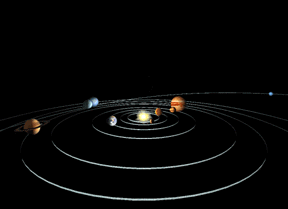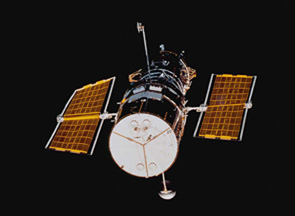Image of a star in the constellation Taurus surrounded by a ring of dust.
Click on image for full size
Image courtesy of STScI
Hubble Images Possible Planet-Forming Systems
News story originally written on February 12, 1999
Scientists using the Hubble Space Telescope's Near-Infrared Camera and
Multi-Object Spectrometer (NICMOS) have taken images of possible
planet-forming regions. The images show disks of dust circling different
stars in the constellation Taurus.
"While the existence of these disks has been known from prior infrared
and radio observations, the Hubble images reveal important new details
such as a disk's size, shape, thickness, and orientation," said Deborah
Padgett of Caltech's Infrared Processing and Analysis Center.
The dust-cloud disks can only be seen edge-on because the stars' light
overpowers the reflected light from the disks. Scientists are interested
in looking at planet-forming regions because they hope to understand how
our Solar System
formed.
You might also be interested in:

Scientists believe that the solar system was formed when a cloud of gas and dust in space was disturbed, maybe by the supernova of a nearby star. Shock waves from the explosion compressed the cloud of
...more
The Hubble Space Telescope (HST) was one of the most important exploration tools of the past two decades, and will continue to serve as a great resource well into the new millennium. The HST is credited
...more
It was another exciting and frustrating year for the space science program. It seemed that every step forward led to one backwards. Either way, NASA led the way to a great century of discovery. Unfortunately,
...more
The Space Shuttle Discovery lifted off from Kennedy Space Center at 2:19 p.m. EST, October 29th. The sky was clear and the weather was great as Discovery took 8 1/2 minutes to reach orbit for the Unitied
...more
A moon was discovered orbiting the asteroid, Eugenia. This is only the second time in history that a satellite has been seen circling an asteroid. A special mirror allowed scientists to find the moon
...more
Will Russia ever put the service module for the International Space Station in space? NASA officials are demanding an answer from the Russian government. The necessary service module is currently waiting
...more
During a period of about two days in early May, 1998, the ACE spacecraft was immersed in plasma associated with a coronal mass ejection (CME). The SWICS instrument on ACE, which determines unambiguously
...more









